Sucrose octasulfate selectively accelerates thrombin inactivation by heparin cofactor II
- PMID: 20053992
- PMCID: PMC2832979
- DOI: 10.1074/jbc.M109.005967
Sucrose octasulfate selectively accelerates thrombin inactivation by heparin cofactor II
Abstract
Inactivation of thrombin (T) by the serpins heparin cofactor II (HCII) and antithrombin (AT) is accelerated by a heparin template between the serpin and thrombin exosite II. Unlike AT, HCII also uses an allosteric interaction of its NH(2)-terminal segment with exosite I. Sucrose octasulfate (SOS) accelerated thrombin inactivation by HCII but not AT by 2000-fold. SOS bound to two sites on thrombin, with dissociation constants (K(D)) of 10 +/- 4 microm and 400 +/- 300 microm that were not kinetically resolvable, as evidenced by single hyperbolic SOS concentration dependences of the inactivation rate (k(obs)). SOS bound HCII with K(D) 1.45 +/- 0.30 mm, and this binding was tightened in the T.SOS.HCII complex, characterized by K(complex) of approximately 0.20 microm. Inactivation data were incompatible with a model solely depending on HCII.SOS but fit an equilibrium linkage model employing T.SOS binding in the pathway to higher order complex formation. Hirudin-(54-65)(SO(3)(-)) caused a hyperbolic decrease of the inactivation rates, suggesting partial competitive binding of hirudin-(54-65)(SO(3)(-)) and HCII to exosite I. Meizothrombin(des-fragment 1), binding SOS with K(D) = 1600 +/- 300 microm, and thrombin were inactivated at comparable rates, and an exosite II aptamer had no effect on the inactivation, suggesting limited exosite II involvement. SOS accelerated inactivation of meizothrombin 1000-fold, reflecting the contribution of direct exosite I interaction with HCII. Thrombin generation in plasma was suppressed by SOS, both in HCII-dependent and -independent processes. The ex vivo HCII-dependent process may utilize the proposed model and suggests a potential for oversulfated disaccharides in controlling HCII-regulated thrombin generation.
Figures

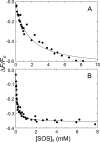
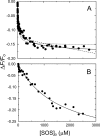
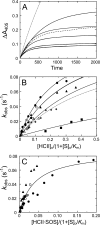
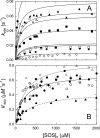
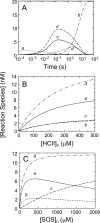
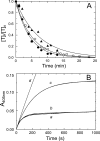
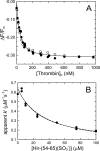


Similar articles
-
The preferred pathway of glycosaminoglycan-accelerated inactivation of thrombin by heparin cofactor II.J Biol Chem. 2004 Mar 12;279(11):9785-95. doi: 10.1074/jbc.M313962200. Epub 2003 Dec 29. J Biol Chem. 2004. PMID: 14701814
-
The complete N-terminal extension of heparin cofactor II is required for maximal effectiveness as a thrombin exosite 1 ligand.BMC Biochem. 2013 Mar 7;14:6. doi: 10.1186/1471-2091-14-6. BMC Biochem. 2013. PMID: 23496873 Free PMC article.
-
Role of thrombin anion-binding exosite-I in the formation of thrombin-serpin complexes.J Biol Chem. 1998 Nov 20;273(47):31203-8. doi: 10.1074/jbc.273.47.31203. J Biol Chem. 1998. PMID: 9813026
-
The interaction of glycosaminoglycans with heparin cofactor II.Ann N Y Acad Sci. 1994 Apr 18;714:21-31. doi: 10.1111/j.1749-6632.1994.tb12027.x. Ann N Y Acad Sci. 1994. PMID: 8017769 Review.
-
The interaction of glycosaminoglycans with heparin cofactor II: structure and activity of a high-affinity dermatan sulfate hexasaccharide.Adv Exp Med Biol. 1992;313:167-76. doi: 10.1007/978-1-4899-2444-5_17. Adv Exp Med Biol. 1992. PMID: 1442260 Review.
Cited by
-
Interaction of thrombin with sucrose octasulfate.Biochemistry. 2011 Aug 16;50(32):6973-82. doi: 10.1021/bi2004526. Epub 2011 Jul 18. Biochemistry. 2011. PMID: 21736375 Free PMC article.
-
Proteases: Pivot Points in Functional Proteomics.Methods Mol Biol. 2019;1871:313-392. doi: 10.1007/978-1-4939-8814-3_20. Methods Mol Biol. 2019. PMID: 30276748 Free PMC article. Review.
-
Fluorescent reporters of thrombin, heparin cofactor II, and heparin binding in a ternary complex.Anal Biochem. 2012 Feb 15;421(2):489-98. doi: 10.1016/j.ab.2011.11.021. Epub 2011 Dec 6. Anal Biochem. 2012. PMID: 22206940 Free PMC article.
-
Glycosaminoglycan-binding properties and kinetic characterization of human heparin cofactor II expressed in Escherichia coli.Anal Biochem. 2010 Nov 15;406(2):166-75. doi: 10.1016/j.ab.2010.07.024. Epub 2010 Jul 27. Anal Biochem. 2010. PMID: 20670608 Free PMC article.
References
-
- Olson S. T. (1988) J. Biol. Chem. 263, 1698–1708 - PubMed
-
- Tollefsen D. M., Pestka C. A., Monafo W. J. (1983) J. Biol. Chem. 258, 6713–6716 - PubMed
-
- Van Deerlin V. M., Tollefsen D. M. (1991) J. Biol. Chem. 266, 20223–20231 - PubMed
-
- Rogers S. J., Pratt C. W., Whinna H. C., Church F. C. (1992) J. Biol. Chem. 267, 3613–3617 - PubMed
-
- Church F. C., Meade J. B., Treanor R. E., Whinna H. C. (1989) J. Biol. Chem. 264, 3618–3623 - PubMed
Publication types
MeSH terms
Substances
Grants and funding
LinkOut - more resources
Full Text Sources
Other Literature Sources
Medical
Miscellaneous

